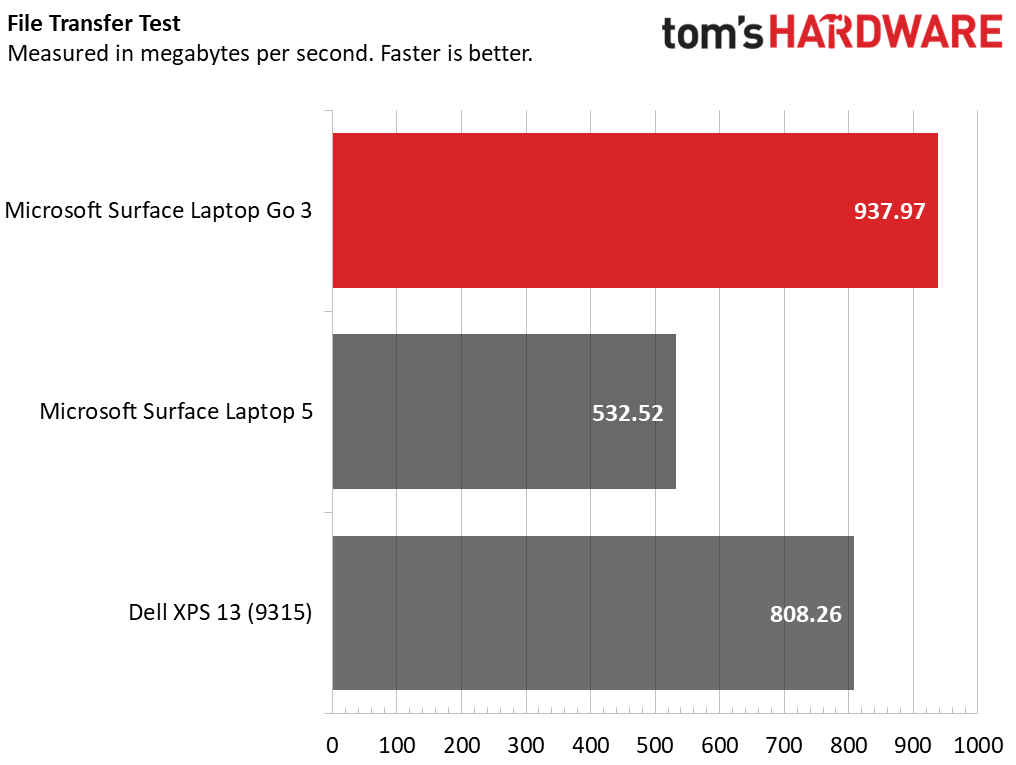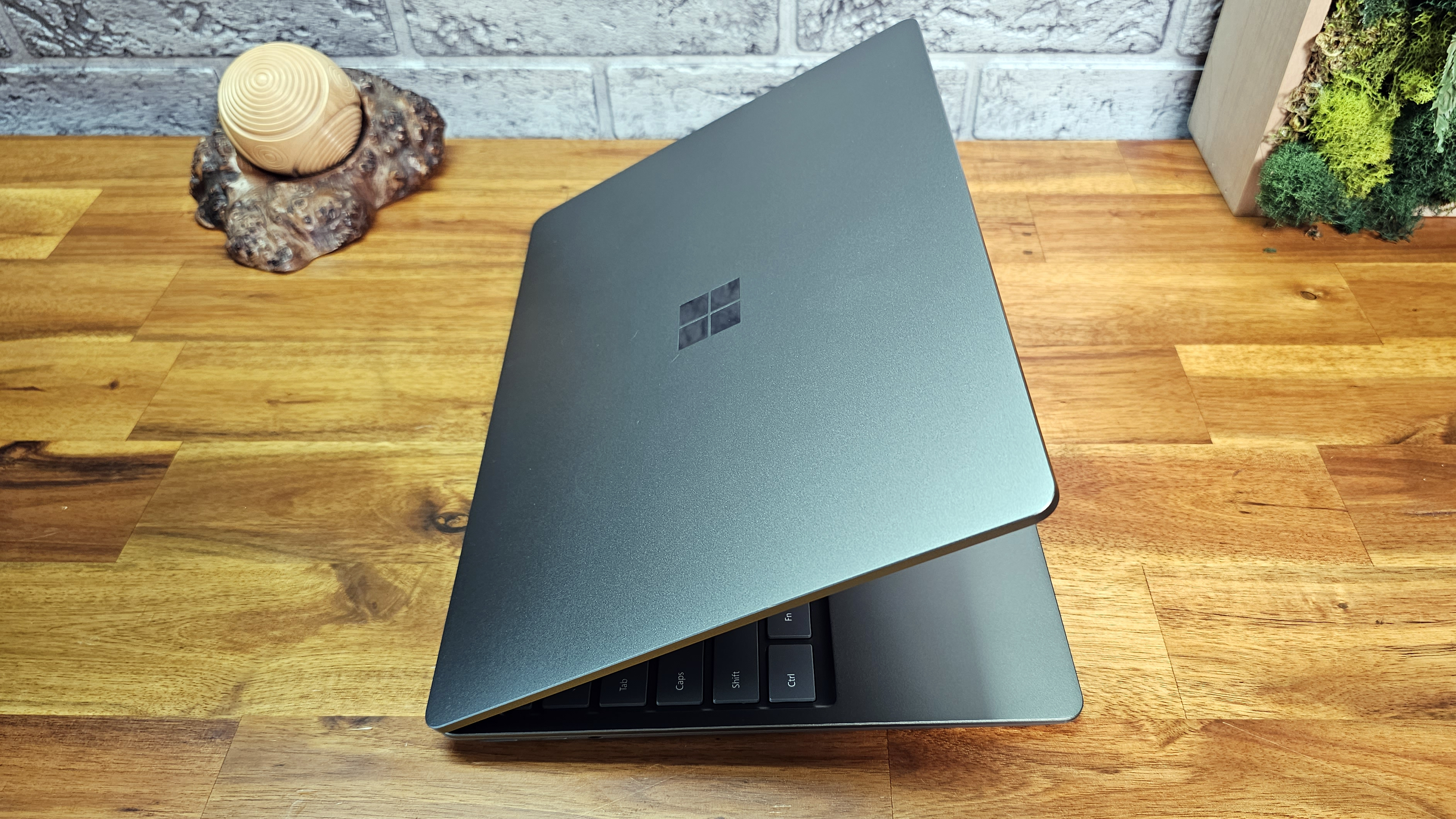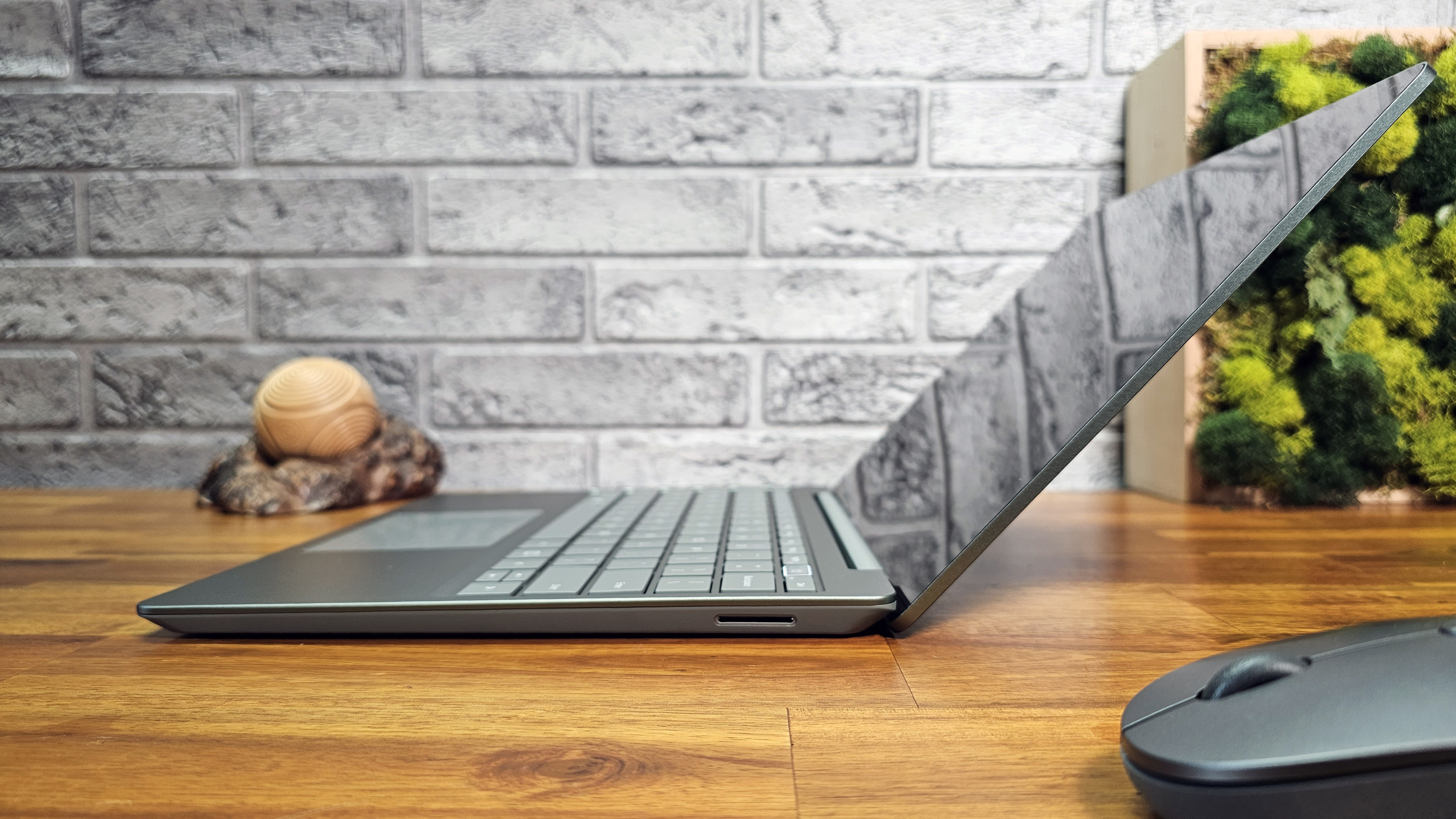Tom's Hardware Verdict
Microsoft's 12.4-inch ultraportable is still pretty and pleasing to use. But with a three-year-old design and a higher $799 starting price ($999 as tested), its sub-1080p screen and lack of keyboard backlighting make it feel like a laptop that’s teleported in from the past.
Pros
- +
Attractive, sturdy, lightweight design
- +
Good key feel and layout
Cons
- -
Performance and battery life could be better
- -
Sub-1080p resolution screen
- -
Keyboard isn't backlit
- -
720p webcam
- -
Starts with just 256GB SSD
Why you can trust Tom's Hardware
Two of my opposing loves in consumer tech are big displays and small laptops. Clearly, with a 12.4-inch screen, Microsoft's Surface Laptop Go 3 isn't going to appeal to the former. But at 2.49 pounds and 10.95 x 8.12 x 0.63 inches, it's smaller and lighter than most modern laptops, which these days tend to start at 13 inches.
At the same time, the Surface Laptop Go 3's dimensions and weight (actually its entire design) are a carryover from 2020, when we reviewed the original Surface Laptop Go. With a three-year-old shell (which admittedly still looks and feels quite nice) and a newer (though not new) Intel 12th Gen CPU, it seems unlikely that Microsoft's latest ultralight will earn a spot on our best ultrabooks list.
One thing that's clearly holding the Surface Go 3 back is (as it was in 2020 with the original model) the laptop's sub-1080p (specifically 1536 x 1024 resolution) display. Considering clamshells that cost less than $300 these days offer up more pixels, the Go 3's $799 starting price (or $999 in our review configuration) is a lot to ask for a laptop with a screen this cramped. And speaking of cramped, both configurations ship with just 256GB of storage.
Design of the Surface Laptop Go 3
The design of the Surface Laptop Go 3 is largely nice. The aluminum shell looks and feels premium, and it comes in four muted colors: platinum (gray/silver), ice blue (blue/silver), sage (green, the color we received), and sandstone (gold/beige). But this is also the same design as the past two Surface Laptop Go models. Specifically, I'd like to see more ports.
The left edge houses a USB-A port, a USB-C port, and the headphone jack.
But the right edge is pretty barren, with just Microsoft's magnetic Surface Connect power slot. Another USB-C port here would be great. In fact, while the magnetic Surface connector is nice in some ways, it feels kind of unnecessary with the ubiquity of USB-C charging these days. And on a laptop this small, Microsoft's connector feels kinda bulky, even though it's very slim.
Overall, there's not a whole lot negative to say about the Surface Go 3's design, other than it's now three years old. And while its 2.5-pound weight is certainly appealing for commuters, Dell's XPS 13 is only slightly heavier (2.59 pounds). The 13-inch MacBook Air is heavier at 3 pounds, but gets much better battery life (as we'll see later).
Microsoft Surface Laptop Go 3 Specifications
| CPU | Intel Core i5-1235U |
| Graphics | Intel Xe Graphics |
| Memory | 16GB LPDDR5 |
| Storage | 256GB PCIe NVMe SSD |
| Display | 12.4 inch, 1536 x 1024, 3:2 Touch display |
| Networking | Wi-Fi 6 (802.11ax), Bluetooth 5.1 |
| Ports | USB Type-C, USB Type-A, 3.5 mm headphone jack, Surface Connect port |
| Camera | 720p webcam |
| Battery | 40 Wh |
| Power Adapter | 39 W |
| Operating System | Windows 11 Home |
| Dimensions (WxDxH) | 10.95 x 8.12 x 0.63 inches |
| Weight | 2.49 pounds |
| Price (as configured) | $999 |
Productivity Performance of Microsoft Surface Laptop Go 3
We tested the higher-end configuration of the Surface Laptop Go, which ships with a 12th Gen Intel Core i5-1235U, 16GB of DDR5, and a 256GB SSD. Aside from the paltry amount of local storage, those specs don't sound awful, But Core i7 chips (and more storage) are often found in laptops in this price range. And newer 13th Gen chips are far more common in Windows machines in 2023.



Starting off with the CPU-focused Geekbench 5 test, the Surface Laptop Go 3 looks good in the single-core test, where its 1,543 score was only significantly surpassed by Apple's MacBook Air (1,733). But every other laptop in our comparison pool (even Microsoft's Surface Laptop 5, which we tested a year ago) does better in the multi-core test. And once again, the MacBook Air's multi-core score of 7,584 blows away the Surface Laptop Go 3's score of 5,883.
Get Tom's Hardware's best news and in-depth reviews, straight to your inbox.
Things didn't look any better for Microsoft's petite portable on our Handbrake video transcoding test. It took the Laptop Go 3 15 minutes and 28 seconds to finish this test. That was enough to edge out last year's XPS 13. But again, Apple's M1 MacBook Air basically cut that time in half (7:44).
Our 25GB file transfer test saw things swing in Microsoft's favor, though that may in part be because we don't have as much competition that we ran this specific test on. The Surface Laptop Go 3 averaged 937.97 MBps, which was well ahead of the Surface Laptop 5's 532.52 MBps, and significantly ahead of the XPS 13's 808.26 MBps as well.
We ran 20 iterations of Cinebench R23 to thermally stress test the Surface Go 3. It started off with 5240.21 points on the first run, dipped below 5,000 on the fourth run, and continued to slowly decline from there, bottoming out at 4645.41 on run 18, before rebounding slightly for the last two runs. During the test, the Core i5’s Performance cores averaged 1.58 GHz and the Efficiency cores reached 1.67 GHz. The processor’s average temperature was 68.4 degrees Celsius.
Display on the Surface Laptop Go 3
The Surface Laptop Go 3's 12.4-inch screen, while it does have touch, starts with the deck stacked against it, because its 1536 x 1024 resolution is below the 1080p or 1280p panels you'll find in most laptops in this price range (and often much lower). Videos and websites look decent enough, but productivity work is definitely tougher here, because you just can't fit as much on the screen here as you can with most laptops.
In our testing, the Surface Laptop Go's screen was decently bright, at 322 nits. But that number puts it behind everything else here, with only the Surface Laptop 5 also landing below 400 nits (384) and Dell's XPS 13 panel being the most bright, at 460 nits.
The Surface Laptop Go 3's color reproduction also lags behind the competition, though not by all that much. At 95% of the sRGB color gamut, it's fairly close to XPS 13 (105%), but Apple's M1 MacBook Air manages 111%. Things are closer together in the larger DCI-P3 space, but Microsoft's screen again comes in last place, delivering just 67.3% of the spectrum.
Keyboard and Touchpad on the Surface Laptop Go 3
Considering that it sits inside a sub-13-inch laptop that's 0.63 inches thick, the keyboard of the Surface Laptop Go 3 is still quite good. Again, it's not changed from previous models, so there's not a whole lot new to say. The layout is about as good as can be expected in a sub-13-incher and the travel is decent for an ultraportable.
Microsoft's One Touch power button / fingerprint reader remains here and works well. But the fact that the button lights up when you use the fingerprint reader is just a reminder that the rest of the keyboard isn't backlit. That made some sense when the original Surface Go started at just $549. But with the Go 3 starting at $799 (thankfully there are no more 4GB models), the absence of a keyboard backlight now feels like a big miss.
The mylar touchpad also remains and is still fine. It feels a little small at 3.9 x 2.6-inches, but it generally works well and there are at least five other things I'd like to see Microsoft update here before it worries about the touchpad.
Audio on the Microsoft Surface Laptop Go 3
One of the substantive changes that Microsoft introduced with the Surface Go 2 was louder speakers. That seems to have carried over to the Surface Go 3, and I have no real complaints about this laptop's sound output. I listened to Front Line Assembly's mid-career instrumental masterpiece "Synthetic Forms," and the layered details, from atmospheric samples, tinkly synths and simple, but evolving baseline all came through with a surprising amount of clarity – even with the volume at 100%.
That said, I mostly kept the volume at 100% while listening to music. Because while these speakers are louder than on the original Surface Laptop Go, they still aren't loud. HP's Dragonfly G4 has much better speakers and weighs a little less (2.2 pounds), but it's also a much pricier ultraportable (at least in most configurations).
Upgradeability of the Microsoft Surface Laptop Go 3
In yet another carryover from the previous-gen Surface Gos, the Go 3 is not designed to be serviceable by the average consumer. The access screws are hidden under the two glued-down feet that run along nearly the entire width of the laptop on the front and back. We didn't attempt to remove them.
So, if you buy this laptop with a 256GB SSD (the only capacity available at press time), you will be stuck with 256GB forever. At a time when you can buy 512GB SSDs for less than $30 and 1TB models for less than $50, the lack of upgradeability is frustrating.
Battery Life on the Microsoft Surface Laptop Go 3
On our battery rundown test, which consists of web browsing, streaming video, and running graphics tests while connected to Wi-Fi with 150 nits of screen brightness, the Surface Go lasted 8 hours and 49 minutes.
That's a decent amount of unplugged run time, especially for a laptop this small. But again that number is well below the competition. The Surface Laptop 5 delivers about the same run time (9:02), but both the XPS 13 (13:11) and Apple's M1 MacBook Air (16:32) lasted several hours longer on the same battery test.
Webcam on the Microsoft Surface Laptop Go 3
There's nothing good to say about the Surface Laptop Go 3's 720p webcam, other than it's better than nothing – barely. I wouldn't even say it's on the good end of the 720p webcam spectrum. Using it in my office in mid-afternoon, I found it produced dark images, while the windows in the room were rectangles of bright, blown-out white. And the lack of detail in my beard and clothes was glaringly evident, even on the sub-1080p screen.
In 2023, this would be a bad webcam on a $300 laptop. Instead, it's in a laptop that costs $1,000 in the configuration I'm testing. Heck, Microsoft's Surface Go 4 (for business) tablet has two 1080p cameras and starts at $579. I'd argue the Surface Go 3's screen resolution and the keyboard's lack of backlight are more substantive issues with this laptop. But given the hybrid work world of today, the webcam here feels like the saddest failing of this device.
Software and Warranty on the Surface Laptop Go 3
Aside from the usual Windows 11 clutter (links in the Start menu to Spotify, WhatsApp and Kindle), there's not a whole lot of extra pre-installed software. The company's recent ClipChamp video editor comes on the device, and there's a link to a new version of Outlook. And the OS will push Microsoft 365 at you – which I'm not saying is a bad thing. I've been a paid user of 365 for more than a decade. In short, other than an extra helping of Microsoft's ecosystem, pre-installed software is minimal.
Microsoft sells the Surface Go 3 with a one-year warranty.
Configurations of the Microsoft Surface Laptop Go 3
As of this writing, you can get the Surface Go 3 in two configurations. The base model with a Core i5, 8GB of RAM and a 256GB SSD sells for $799. Our review configuration sticks with the i5 (a Core i5-1235U, specifically), while doubling the RAM to 16GB while, annoyingly, sticking to the 256GB of storage. Clearly, the company expects you to use OneDrive for storage, because 256GB is a joke for any laptop in 2023, particularly one that costs $799 or $999.
Bottom Line
The Surface Laptop Go 3's basic design still holds up pretty well, given it's basically the same laptop we saw with the first model in 2020. It looks good and feels solid, while being quite light at 2.49 pounds. And despite the cramped quarters afforded by the 12.4-inch screen, the keyboard is surprisingly comfortable to type on – until it gets dark and you're reminded that this is a $999 laptop (or $799 to start) that lacks backlighting.
And therein lies the rub with the Surface Laptop Go 3: Microsoft's refusal to substantially update it means major features (screen resolution, keyboard, webcam, performance) don't match up with the competition – sometimes within Microsoft's own product line. The Surface Go 4 (for business has a 1920 x 1280 display and two 1080p cameras (front and back) and starts at $579 (though you'll have to pay $99 more for the keyboard). Alternatively, the 13.5-inch Surface Laptop doesn't weigh much more than the Laptop Go (2.86 pounds) while sporting backlit keys and a much higher-res (2256 x 1504) display (though it also has a 720p webcam), starting at $899.
The Dell XPS 13 weighs a few tenths of a pound more, but it's a far better value, offering a higher resolution display, a backlit keyboard, a similar Core i5 12th Gen CPU, 16GB of RAM and a 512GB SSD for just $849 at press time.
And for those not wedded to Windows, Apple's 13-inch M1 MacBook Air delivers much better battery life, generally better performance, and a brighter 2560 x 1600 screen at $999. Clearly, Microsoft needs to make major changes if it plans to continue selling the Surface Laptop Go after this third iteration. But I wouldn't be surprised if the company ends its tiny laptop line here, which would be sad because I like premium sub-13-inch laptops, and there aren't that many left.
After a rough start with the Mattel Aquarius as a child, Matt built his first PC in the late 1990s and ventured into mild PC modding in the early 2000s. He’s spent the last 15 years covering emerging technology for Smithsonian, Popular Science, and Consumer Reports, while testing components and PCs for Computer Shopper, PCMag and Digital Trends.
-
kyzarvs both configurations ship with just 256GB of RAM.Reply
Typo? I've only ever had servers with that much RAM...










